
risk_reversal
Content Type
Profiles
Forums
Events
Posts posted by risk_reversal
-
-
I multi boot a system with 98SE which currently has 1GB ram. I wanted to increase the system ram to 2Gb.
My current settings in System.ini running 1Gb are as follows:
[386Enh]
ConservativeSwapfileUsage=1
[vcache]
minfilecache=131072
maxfilecache=262144
98SE runs fine with no issues.
I have read the following thread as regards adding >1Gb of ram to 98SE and understand that I can choose one of two possible routes as regards the ram upgrade.
1. Where 98SE will only see about 1Gb of the physical ram by way of using HimemX.exe
2. Using the rloew patch where 98Se will see however much physical ram is installed
Firstly I hope that I have correctly understood the above 2 available options.
Option 1. using HimemX.exe is fine with me.
I understand that the proceedure for this would entail
1. Downloading the file from http://japheth.de/Jemm.html and extracting the HimemX.exe file
2. Placing that file in C:\Windows
3. Adding DEVICE=C:\WINDOWS\HIMEMX.EXE in CONFIG.SYS
I also understand that I will have to further edit the System.ini file , namely settings in [386Ehn] & possibly in [vcache].
Adding the extra 1GB of ram will require that I change [386Ehn] to
[386Enh]
ConservativeSwapfileUsage=1
MaxPhysPage=40000 (or so ie 1Gb) <-- add this line
I may also need to tweak the min/maxfilecache values and perhaps add a chunks entry
[vcache]
minfilecache=131072 <--may need to be tweaked
maxfilecache=262144 <--may need to be tweaked
ChunkSize=1024 <-- maybe add this
Now have I understood all this correctly so far. If so, here is my question
The second post on the day-to-day-running-win-9xme-with-more-than-1-gib-ram thread,
shows the user configuration list. The last entry in user's configuration specifies the
following
vmm32.vxd: plain vanilla (with 4.10.0.2222 vcache.vxd and vmm.vxd inside)
Forgive my ignorance but I am baffled. Can someone please explain what this entry means.
I have a vmm32.vxd file and VMM folder in C:\Windows\System but no vache.vxd or vmm.vxd files and
I really do not understand what this refers to.
Many thanks for any info provided.
0 -
Thanks a LOT risk_reversal. Looks like a very useful card. Are there any Win98/Vista/Linux compatible WLAN cards, with detachable antenna AND the a-frequencies? That would be an ideal WLAN card. Edimax apparently has no a/b/g dual-band WLAN cards.The Edimax EW-7128G has 98SE drivers... in addition is Linux compatible.The only other card which I found that might work with 98SE and which has 'a' mode was the Cisco Aironet 802.11A/B/G Wireless PCI Adapter (pretty sure it was this one, the drivers are available on the Cisco site just have to hunt them down). This card has wpa and I am sure that the Aegis3 98SE supplicant would also work. Also has removable aerial [reverse SMA, I think]
I did consider this card seriously but my understanding is that it is no longer manufactured and can only / sometimes be found on fleebay. This card was apparently extremely expensive when new.
Good Luck
0 -
The Edimax EW-7128G has 98SE drivers which can be downloaded from the edimax.com site. The card works well in 'G' mode. This is a pci wifi card. I know you were specifically asking about usb wireless but perhaps this may nevertheless be of interest.
http://www.newegg.com/Product/Product.aspx?Item=N82E16833315041
I have ADSL2+ and download throughput is about 11,500 kbps. Edimax will also provide the Aegis3 driver which is the supplicant so that the card can be enabled to work with wpa encryption (this also works fine on my Edimax card).
The card has a Ralink RT25xx chipset which in addition is Linux compatible.
Good Luck
0 -
On 98SE, I still run Norton 2003 AV which works well. I know that there was reference to the 2002 version earlier on in this thread.
In respect of malware SuperAntiSpyware works great up to v4.24.1004. The definitions file is getting a bit big now and load times slow down but there is a right click context menu entry to scan individual files.
wsxedcrfv said:I remove the drive from the system and attach it as a slave to the trusted system and scan it
You could also try one of the following for on-demand scanning.
1. Run the AntiVir AV Rescue boot CD. It's Linux based and will see all the partitions on the HD (hidden partitions also).
The AV definitions are updated regularly.
2. Alternatively, install Linux on a small partition and then you can install and run Avast to scan other partitions.
3. I used to use the ESET (NOD32) on line scanner but although some say that it still works for 98SE, I have found it difficult to access it lately (perhaps my Java is not recent enough).
Good Luck
0 -
Given that no one has mentioned running 98SE from a virtual machine I will do so.
I use VirtualBox (but VMWare another option) on one machine to run 98SE within XP partition. It may be worth looking at.
Good Luck
0 -
Win98SE will have no issues at all with 512Mb of ram. You will need to tweak nothing at all and I find that it runs very well indeed with that amount of ram.
I used to run a laptop with 98SE (Dell Latitude C600) on which I upgraded the cpu to the max 1ghz (max ram is also 512Mb). The C600 has the Intel BX440 chipset which I always found to be excellent.
A couple of years ago I upgraded that laptop with XP and gave it to one of my children and it still runs fine and fast to this day (it has needed replacement parts to keep it going).
Reason why I personally prefer Dell (I have 3 of them) is that their site has all the dismantling schematics and drivers readily available. The other reason I prefer Dell is that if I need to replace a component on any of my laptops then they are usually easy to find on fleebay.
EDIT: see also this thread (first post / first para) where the user found the required drivers for 98SE
http://www.msfn.org/board/index.php?showtopic=140636
Good Luck
0 -
Many thanks. Apologies for late reply been ill.
Cheers
0 -
triger49 said:
If it puts back something that does not belong there,
look at ....
C:\windows\INF\OTHER\
You'll usually find the offending inf file there.
Cheers triger49. I was aware of that folder but in saying this, I did check that folder's contents and found a CTX inf file that I can also probably remove. I think this file is related to the monitor's driver which is also listed as a ghost entry in device manager and which I was also going to remove.
dencorso said:Sure. You may delete these 4 entries. It's safe.
Many thanks
There are 2 other ghost entries in device manager which I would like your advice on. I was going to leave them but what do you think. The 2 branches under Human Interface Device.
I think the CTX USB Monitor branch can go but I am puzzled by the HID compliant device which I did try to search for but found confusing results. These also only show up in Safe Mode.
Good Luck
0 -
I am trying to tidy up the 2 ghost entries [CTX USB Hub] in Device Manager relating to my old CTX monitor's USB hub. These show up while in Safe mode.
Under the Universal Serial Bus Controller heading, I have also noted 2 ghost entries for Unknown Device. These also only show up in Safe Mode.
I was going to delete the 2 CTX USB Hub entries but was wondering if the 2 Unknown Device ghost entries can also be safely deleted. I am sure they can but perhaps someone can confirm this please.
I understand that whatever I delete, windows will rebuilt the driver files ie drvdata.bin & drvidx.bin at reboot.
Many thanks for any info provided
Cheers
0 -
Cheers.
I did search prior to posting and saw that the installer was different. Guess I will go for the classic.
0 -
Apologies for my ignorance but which version are you guys downloading / recommending
Classic Installer, English (US) or English (US)
Cheers
0 -
dencorso said:
No problem! Here:
For HDDs connected directly through the motherboard, you find their entries in:
HKLM/Enum/ESDI/GENERIC_IDE__DISK_TYPE47_/ --> for IDE (=PATA) HDDs
or
HKLM/Enum/SCSI/ --> for SCSI, SATA and USB HDDs
Many thanks. I opened all the keys in HKLM/Enum apart from that one.....................The Device Manager looks very professional with everything correctly labeled.
CharlotteTheHarlot said:It never amazes me how folks spread out on the four corners of the globe wind up tinkering away accomplishing identical achievements without some how-to guide!
Must admit that would be useful as I still dual boot on 2 systems and my wife's system for which this Dell 1907FPV panel was installed only has 98SE [she says she is used to it and does not want anything else].
When I built my last system about 3 years ago [Mobo Asus A8VDeluxe Rev2, Via K8T800Pro chipset] and needed to get info as regards win98 dual booting on the Promise controller [the Asus has 2, the Via and Promise] it was a devil of a job to get all the relevant info.
Still I suppose that half the fun is digging out the info and the testing and messing about

In any case many thanks for all the info [inc registry string length] which I have carefully noted. Hopefully this thread will help others. At the very least when another one of my CRT screens goes caput then all the donkey is already done for me.
Cheers
0 -
Many thanks for your added replies and comments guys.
What I did in the first instance was edit the DeviceDesc field from "Generic USB HUb" to "Dell USB Hub" bearing my mind your comments.
Once changed in the registry, USBView correctly showed the edited string without any issues. Similarly all relevant entries in Device Manger under Universal Serial Bus controllers were correct.
Once this change had been done I quickly did a test. I have a printer connected to a port of the hub and switched it on. It was also correctly detected in both Device Manager & USBView. I test printed a few pages from various sources ie word & web page and all seemed fine.
I have attached below a screenshot of USBView with printer
I will be carrying out further tests connecting flash drives, etc to the hub just to make sure that there are no potential intermittent issues but at this stage I would say that all is working well with this new panel.
Again many thanks for your kind help.
Cheers
[EDIT:] dencorso without wishing to go off topic but as regards changing the DeviceDesc of the HDDs where is it located. I have looked in the HKLM/Enum key and cannot find it. I see the floppy, opticals and other assorted hw but not the HDD.
0 -
dencorso said:
You can freely change the string under Device Desc, and that's the string that appears in the Device Manager, as well as everywhere the device is identified, so it should suffice.
I'm not sure what happens in case you also change the Mfg string, though.
Cheers, will give it a go.
dencorso said:BTW, you said "As per above my mobo has usb1.1 and I was using NUBS v2.4". But you didn't upgrade NUSB, afaik, so you ought to have said "and I am using NUSB 2.4", right?
Yes, correct I am using NUSB v2.4.
dencorso said:Also, there is a typo in your NUSB: "S" and "B" are reversed. Bear with me, please, I'm not nitpicking: we both know what you're talking about, but I'm thinking of someone not familiar with the subject might read that and be confused.
Yes, sorry mate typo.
CharlotteTheHarlot said:QUOTE (risk_reversal @ Oct 1 2009, 01:31 PM) *
I connected the TFT and the new hardware found wizard opened and installed the panel which correctly shows up as Dell 1907FPV in Device Manager.
I then connected the USB hub. Again, the new hardware found wizard opened and installed the usb hub as Generic USB Hub [just as you said dencorso, cheers].
Cool! And thanks for posting back.
No probs, pleased to be able to give some feedback to other 98SE users.
CharlotteTheHarlot said:QUOTE (risk_reversal @ Oct 1 2009, 01:31 PM) *
Is it possible to change the identifier ie 'Generic USB Hub' in the registry or not?
ie >HKLM/Enum/USB, find the correct key and change the DeviceDesc Generic USB Hub & Mfg "(Generic USB Hub)" respectively to say Dell USB Hub & Dell. Would this work, or lead to issues ie 98SE &/or NUSB confusion? If this change can be made would it be a global change or would I need to change other registry keys.
QUOTE (dencorso @ Oct 2 2009, 02:34 AM) *
You can freely change the string under Device Desc, and that's the string that appears in the Device Manager, as well as everywhere the device is identified, so it should suffice.
I'm not sure what happens in case you also change the Mfg string, though.
Yup. I've been doing this myself on Win9x systems for a long time with very few problems.
To be safe, just don't exceed the length of the original entry, some of these "DeviceDesc" appear to be fixed length fields (within their respective keys)
Cheers and noted thanks.
CharlotteTheHarlot said:Notice the field lengths were maintained after editing.
Confused..Must the field lengths be maintained or not exceeded? ie if the DeviceDesc filed is Generic USB Hub can I not replace it with Dell USB Hub?
I have posted a pic of the reg key below. From the link above it looks like VID 0424 is Standard Microsystems Corp with the PID 2504 as USB 2.0 Hub
Cheers
0 -
Well finally bought the Dell LCD panel, 1907FPV. Finding this panel was a real chore.
In any case, I connected the TFT and the new hardware found wizard opened and installed the panel which correctly shows up as Dell 1907FPV in Device Manager.
I then connected the USB hub. Again, the new hardware found wizard opened and installed the usb hub as Generic USB Hub [just as you said dencorso, cheers].
In case this is of use to anyone. As per above my mobo has usb1.1 and I was using NUBS v2.4.
I do have one final question. Is it possible to change the identifier ie 'Generic USB Hub' in the registry or not?
ie >HKLM/Enum/USB, find the correct key and change the DeviceDesc Generic USB Hub & Mfg "(Generic USB Hub)" respectively to say Dell USB Hub & Dell. Would this work, or lead to issues ie 98SE &/or NUSB confusion? If this change can be made would it be a global change or would I need to change other registry keys.
Cheers
0 -
If you only want to charge it, why not also consider getting a genuine Apple mains charger. They are only not expensive on fleebay
http://electronics.shop.ebay.co.uk/i.html?...amp;_osacat=293
http://cgi.ebay.co.uk/Genuine-Apple-Ipod-M...id=p3286.c0.m14
0 -
Cheers dencorso.
dencorso said:Both are seen by USBView 5.1.2600.2180
I also downloaded USBView and it looks like a really hepful utility. Many thanks for mentioning it.
Good Luck
0 -
dencorso said:
Now I've rebooted into Win 98SE and did some tests: NUSB 3.3 has recognized each of two different USB HUBs I plugged into the ports. One is a USB 1.1 HUB (VID = 03EB [=Atmel Corp.] PID = 0902) and the other a USB 2.0 HUB (VID = 05E3 [=Genesys Logic, Inc.] PID = 0608). For the recognition of the former nothing was required, and for the latter it displayed the "Add Driver" dialog box (as usual) and I clicked OK as needed (as usual), and NUSB took over (as usual), and that's all. Both get labeled "Generic USB Hub". Both are seen by USBView 5.1.2600.2180, and both work perfectly.
Many thanks for the info dencorso.
My mobo is an older board with USB1.1 ports ONLY and the version of NUSB used is v2.4. You did not mention the USB capabilities of the board which you used but I suspect that if you used NUSB v3.3 it might have been a USB2.0 enabled board.
Question please: Any reason in principle to suggest that the USB hub dectection would not work with my older USB and NUSB version ie is the INF in v3.3 materially different to the one in v2.4.
dencorso said:BTW, of course, if you just plug in the hub, while you don't attach any storage device to it you'll not have the "Safely Remove Hardware" icon in the tray, because there is nothing to stop in a hub.
That will do nicely for me.
CharlotteTheHarlot, many thanks for your reply and further clarity on this matter. I do hope that it will be good news from what dencorso has said.
CharlotteTheHarlot said:But still, I'd snapshot the registry beforehand so you can manually rollback if necessary (save the System.dat also which makes for a real easy rollback ;-).
I was going to save the registry, take a snapshot with second chance and image the whole partition [images for dos] prior to doing anything.
My wife is busting my chops with the current monitor as it intemittently goes off so I am on the case to purchase this panel asap. I will post back once I have the panel in hand and can provide any info as to how the install went.
Many thanks for your kind help
0 -
CharlotteTheHarlot said:
Definitely not fun! No way to kill the USB 1.1 and legacy serial ports in the BIOS? Do you need LPT? Maybe kill the NIC or modem too (lots of systems have both, but few need both)? This should free up one or possibly two IRQs.
Serial ports and LPT already disabled in the bios.
CharlotteTheHarlot said:Just looked at it. Typical Dell file, just puts the monitor into the registry. Apparently their plan is for the computer to PnP the hub, unless they have some supplemental file somewhere. It is coded for Chicago, so it will be fine on Win98.
Ok good to know at least that the monitor files would work in 98SE. Otherwise, if I don't install this driver file then the monitor will come up in Device Manager as something like 'Default Monitor'
CharlotteTheHarlot said:Its worth a shot to see if Win98+NUSB will recognize the hub. Be sure to do the monitor without the hub first (reboots, and make sure it sticks in display properties), then only move on to the USB wire after it is ok. No sense confusing things
If the monitor is detect albeit as Default Monitor should I still attempt to install the Dell files?
Was reading the NUBS thread again and on page 10 MDGx links to a vendor ID page
http://www.msfn.org/board/maximus-decim-na...5-page-180.html
http://www.linux-usb.org/usb.ids
Which has a Dell 1905FP. I guess the VID is 413c & PID a700 [Hub (in 1905FP LCD Monitor)]
I thought one could just add the entries to NUSB, similarly to what this guy did below.
[Manufacturer]
%CnMemory.Mfg%=CnMemory
[CnMemory]
%USB\VID_1516&PID_8628.DeviceDesc%=USBSTOR_BULK,USB\VID_1516&PID_8628
[strings]
CnMemory.Mfg="CnMemory"
USB\VID_1516&PID_8628.DeviceDesc="Generic USB Flash Disk"
However, not sure NUSB is configured to install USB Hubs. I do not know enough about it.
CharlotteTheHarlot said:NOTE: porting settings is the hardest method for sure! And porting USB settings is really tough because of the nature of the ConfigMg detection. To put it plainly, most hardware are using identical identification strings and registry from one computer to another, USB stuff almost never is. So, when undergoing the massive effort of manually porting a USB device, it had better be worth it!
I take it you mean trying to configure an INF file and set up registry settings is going to be very difficult. Maybe I should just rebuilt this pc with a USB2.0 enabled board.
Question if I have the original CTX USB hub driver / .inf file. Would amending that be an easy solution ie change .INF settings of file and I can see the registry entries of the CTX Hub
Many thanks for the added info
0 -
Many thanks for the added info.
CharlotteTheHarlot said:I suspect all that is really needed is an INF file detailing the ID's for the USB hub, because all the system files are probably present already from the NUSB package.
Think I will have a stab at making up an INF file with the necessary info and see whether that works.
Cheers
0 -
CharlotteTheHarlot said:
Well, since you are planning on springing for a new display I'd suggest tacking on an extra $9 onto the order and get a USB 2.0 PCI card (if you have a slot free naturally). This is because legacy USB 1.1 is too painful to comprehend (IMHO)! Flashdrives, Cameras and External HDD's on USB 1.1? You will be much happier after changing this!
Next, I would concentrate on getting this USB 2.0 working first, without ever plugging in the USB wire from the new monitor. Once it is working OK then I would try to get the monitor's USB hub working, but this is definitely secondary (at least to me).
Did try to install a pci USB2.0 card sometime back and had a lot of issues with it. The only available vacant slot was 5 [1 being shared by the AGP slot] and it caused lock up issues.
CharlotteTheHarlot said:I suspect all that is really needed is an INF file detailing the ID's for the USB hub, because all the system files are probably present already from the NUSB package. The pertinent data may even be included in the new monitor's INF (as you probably are aware Dell monitors typically come with 3 files, for example: E173fp.cat , E173fp.icm , E173fp.inf
Following your comment, I set about doing a more thorough search and found a driver file on the Dell site which I thought was to do with the correct detection and identification of the panel only. The driver file is R119568 and contains a 1907fp.cat, 1907fp.ecm & 1907fp.inf.
http://support.dell.com/support/downloads/...p;fileid=158980
The contents of the zip are as per pic below
CharlotteTheHarlot said:The INF for a new monitor with a USB hub *may* have the data inside. Or, maybe not.
Are you saying that 1907fp.INF may be 1. Info just for the panel only or 2. that the INF will contain info on the panel and the USB hub.
Is there any way to tell? I have looked inside the 1907fp.inf file and can only see info as regards the panel.
CharlotteTheHarlot said:If you have no luck tracking down a Win98 compatible INF file for the new monitor's USB hub, I can think of one way to kind of 'capture' them. I just might hook the new monitor to a WinXP system (or maybe even WinME) insert the driver CD, and make careful snapshots of the registry (and file copy activity) before and after. At the end of this, a .INF or .REG can likely be created.
Question: I am guessing that if I connect the panel to an XP machine and attach the USB hub to a port on my mobo, that XP will auto detect the hub and install it. Pretty much in the same way that it auto detects other stand alone hubs that I have attached to it before. So why use the CD. Apologies if I am being particularly stupid here.
Any further info or advice much appreciated.
Cheers
0 -
Many thanks for your reply eksasol.
The link which you posted is correct. I do use NUSB [v2.4] already and it is very good with 100% record so far detecting flash drives, cameras, external HDDs.
However, I am not sure it will work [ie detect and install] the actual USB hub itself and more so since my mobo only has USB v1.1. Hence why I was posting to get some feedback. I cannot believe 98SE users do not use any kind of USB hub.
The panel I was interested in purchasing is the Dell 19" 1905FP or 1907FP.
Any info much appreciated
Cheers
0 -
My old CTX 17" CRT monitor is failing, it has a USB hub incorporated into the swivel base.
I was looking to replace it with a Dell LCD panel which also has a built in USB hub.
When I got the CTX years ago, I had to install a driver [supplied by CTX] so that 98SE would recognize the USB hub.
My mobo is Via based [266B chipset] and only has USB1.1
Question:
Presumably the USB hub in the Dell LCD panel will also require a driver? I have looked on the Dell site and none were listed [understandibly].
I was wondering whether NUSB would recognize the USB hub or whether it was merely for flash type drives ie thumb drives, camera, etc and external hard drives.
Any info as to whether the Dell built in USB hub will work natively with 98SE or advice as to how I should proceed would be most appreciated.
Cheers
0 -
I have tried Edimax wifi cards [both pci & cardbus] and they seem to work well. The 2 models I installed were the EW-7108PCG & EW-7128G.
I also installed a Netgear WG311 pci card in a relative's machine who has 98se and it also works well. I think it was a v1 card. No WPA supplicant was supplied but you can use the Aegis from the Edimax.
The Edimax cards both have the Ralink chipset. I downloaded the latest / last 98SE drivers from the Edimax.com site.
You can also get the card to work with WPA encryption by installing the WPA supplicant [Aegis2] which you will find in Program Files>Edimax folder. Otherwise it's only WEP.
A bit late but hope this helps
Cheers
0

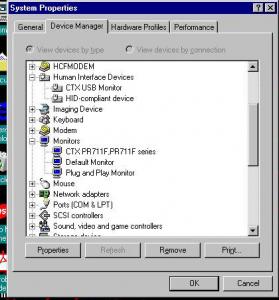
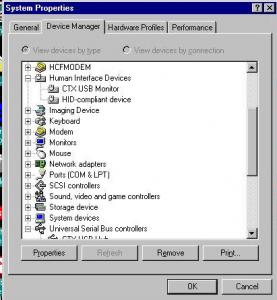
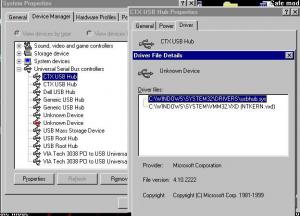
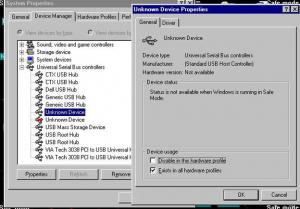
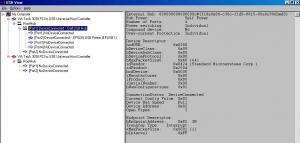
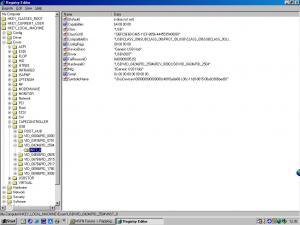
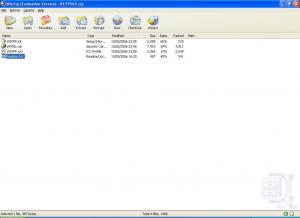
Want to increase ram 1Gb-->2Gb - Question
in Windows 9x/ME
Posted · Edited by risk_reversal
Many thanks for your clarity. Following you explanation, I searched and found this page which helped completely clear it up.
http://www.helpwithwindows.com/techfiles/vmm32.html
I appreciate that information as regards the build version of the VMM32.VXD file would be very useful.
Hopefully a final question. Using the example above
vmm32.vxd: plain vanilla (with 4.10.0.2222 vcache.vxd and vmm.vxd inside)
How can I tell which version vmm32.vxd I have and more specifically whether it contains 4.10.0.2222 vcache.vxd and vmm.vxd inside (or another version). If you see what I mean?
If I right click my vmm32.vxd, there is no tab on the box that opens which provides that info.
If I go to HKEY_LOCAL_MACHINE\System\CurrentControlSet\Control\VMM32Files
I can see vcache.vxd but no vmm.vxd.
Apologies again for being so stupid.
Cheers